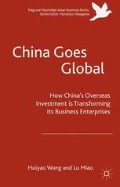Abstract
Chinese business enterprises are going global. By doing so, they are reinventing China economically once again, transforming the country from being merely a platform for exporting low-grade manufactured goods such as textiles and apparel into a major force for overseas investment. The rise of China, along with its emerging economy counterparts Brazil and India as major sources of overseas investment, is arguably the biggest unfolding business story today. According to Goldman Sachs, these three emerging giants will account for half of all global business activity by 2050.1
Access this chapter
Tax calculation will be finalised at checkout
Purchases are for personal use only
Preview
Unable to display preview. Download preview PDF.
Notes
Mathews, John. “China, India and Brazil: Tiger Technologies, Dragon Multinationals, and the Building of National Systems of Economic Learning.” Asian Business & Management. Volume 8 (2009): 5–32.
Dunning, J. H. “Trade, Location of Economic Activity and the MNE: Search for an Eclectic Approach.” Ohlin, B., Hesselborn, P. O., and Wijkmon, P. R. [eds.]. The International Location of Economic Activity. London: Macmillan (1977): 394–418 and Multinational Enterprises and the Global Economy. Boston: Addison-Wesley (1993).
Huang, Yasheng. Selling China: Foreign Direct Investment during the Reform Era. New York: Cambridge University Press (2002).
Buckley, P. J. “Asian Network Firms: An Analytical Framework.” Asia Pacific Business Review. Volume 10 (2004): 254–271
and Buckley, P. J., Clegg, J., Cross, A., Liu, X., Voss, H., and Zhen P. “The Determinants of Chinese Outward FDI.” Journal of International Business Studies. Volume 38 (2007): 499–518; hereafter cited as Buckley [et al.]. “Determinants of Chinese Outward FDI.”
Feng, T. and Wang, G. “How Private Enterprises Establish Organizational Legitimacy in China’s Transitional Economy.” Journal of Management Development. Volume 29 (2010): 371–393.
Taylor, Robert. “Globalization Strategies of Chinese Companies: Current Developments and Future Prospects.” Asian Business & Management. Volume 1 (2002): 209–225.
Cui, Lin and Jiang, Fuming. “Ownership Decisions in Chinese Outbound FDI: An Integrated Conceptual Framework and Research Agenda.” Asian Business & Management. Volume 8 (2009): 301–324;
Deng, P. “Why Do Chinese Firms First Tend to Acquire Strategic Assets in International Expansion?” Journal of World Business. Volume 44 (2009): 74–84;
Du, M. and Boateng, A. “State Ownership, Institutional Effects and Value Creation in Cross-Border Mergers and Acquisitions by Chinese Firms.” International Business Review. Volume 24 (2015): 430–442.
Luo, Y, Xue, Q., and Han, B. “How Emerging Market Governments Promote Outward FDI: The Experience of China.” Journal of World Business. Volume 19 (2012): 68–79;
Robins, Fred. “The Uniqueness of Chinese Foreign Direct Investment.” Asian Business and Management. Volume 12 (2013): 525–537;
Wang, C, Hong, J., Kafouros, M., and Boateng, A. “What Drives Outward Investment of Chinese Firms? Testing the Explanatory Power of Three Theoretical Frameworks.” International Business Review. Volume 21 (2012): 425–438; hereafter cited as Wang [et al.]. “What Drives FDI of Chinese Firms?”.
Buckley [et al.]. “The Determinants of Chinese Outbound FDI”; Dunnning, J. H. “Relational Assets, Networks, and International Business Activities.” Contractor, F. J. and Lorange, P. [eds.]. Cooperative Strategies and Alliances. Oxford: Elsevier (2003): 569–593;
Eller, M., Haiss, P., and Steiner, K. “Foreign Direct Investment in the Financial Sector and Economic Growth in Central and Eastern Europe: The Crucial Role of the Efficiency Channel.” Emerging Markets Review. Volume 7 (2006): 300–319.
Cheung, Y. W. and Qian, X. Y. “Empirics of China’s Outbound Investment.” Pacific Economic Review. Volume 14 (2009): 499–518;
Huang, Yasheng and Wang, B. J. “Chinese Outward Direct Investment: Is There a China Model?” China & World Economy. Volume 19 (2011): 1–21;
and Zhang, X. and Daly, K. “The Determinants of China’s Outward Foreign Direct Investment.” Emerging Markets Review. Volume 12 (2011): 389–398.
Wei, Y, Zheng, N., Liu, X., and Lu, J. “Expanding to Outward Foreign Direct Investment or Not? A Multidimensional Analysis of Entry Mode Transformation of Chinese Private Exporting Firms.” International Business Review. Volume 23 (2014): 756–770.
Kubny Julia and Voss, Heinrich. “Benefitting from Chinese FDI? An Assessment of Vertical Linkages with Vietnamese Manufacturing Firms.” International Business Review. Volume 23 (2014): 731–740;
Schüler-Zhou, Y and Schüller, M. “An Empirical Study of Chinese Subsidiaries’ Decision-Making in Germany.” Asian Business & Management. Volume 12 (2013): 321–350;
Yiu, Daphne W., Ng, Frank, and Ma Xufei. “Business Group Attributes and Internationalization Strategy in China.” Asian Business & Management. Volume 12 (2013): 14–36,
Dunning, J. H. and Lundan, S. Multinational Enterprises and the Global Economy. Cheltenham: Edward Elgar (2008) and Huang and Wang. “Chinese Outward Direct Investment.”
Alon, I., Fetscherin, M, and Gugler, P. [eds.]. Chinese International Investments. London: Palgrave-Macmillan (2012).
Author information
Authors and Affiliations
Copyright information
© 2016 Huiyao Wang and Lu Miao
About this chapter
Cite this chapter
Wang, H., Miao, L. (2016). Scholarly Context of This Book. In: China Goes Global. Palgrave Macmillan Asian Business Series. Palgrave Macmillan, London. https://doi.org/10.1007/978-1-137-57813-6_1
Download citation
DOI: https://doi.org/10.1007/978-1-137-57813-6_1
Publisher Name: Palgrave Macmillan, London
Print ISBN: 978-1-349-84623-8
Online ISBN: 978-1-137-57813-6
eBook Packages: Business and ManagementBusiness and Management (R0)

